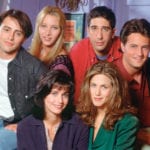 Movies and TV
Movies and TV  Movies and TV
Movies and TV  Health
Health 10 Miraculous Advances Toward Curing Incurable Diseases
 Miscellaneous
Miscellaneous 10 Undeniable Signs That People’s Views of Mushrooms Are Changing
 Animals
Animals 10 Strange Attempts to Smuggle Animals
 Travel
Travel 10 Natural Rock Formations That Will Make You Do a Double Take
 Movies and TV
Movies and TV 10 Actors Hidden in Your Favorite Movies
 Our World
Our World 10 Science Facts That Will Change How You Look at the World
 Pop Culture
Pop Culture 10 Incredible Female Comic Book Artists
 Crime
Crime 10 Terrifying Serial Killers from Centuries Ago
 Technology
Technology 10 Hilariously Over-Engineered Solutions to Simple Problems
 Movies and TV
Movies and TV 10 Movie Adaptions That Brought Popular Songs to Life
 Health
Health 10 Miraculous Advances Toward Curing Incurable Diseases
 Miscellaneous
Miscellaneous 10 Undeniable Signs That People’s Views of Mushrooms Are Changing
Who's Behind Listverse?

Jamie Frater
Head Editor
Jamie founded Listverse due to an insatiable desire to share fascinating, obscure, and bizarre facts. He has been a guest speaker on numerous national radio and television stations and is a five time published author.
More About Us Animals
Animals 10 Strange Attempts to Smuggle Animals
 Travel
Travel 10 Natural Rock Formations That Will Make You Do a Double Take
 Movies and TV
Movies and TV 10 Actors Hidden in Your Favorite Movies
 Our World
Our World 10 Science Facts That Will Change How You Look at the World
 Pop Culture
Pop Culture 10 Incredible Female Comic Book Artists
 Crime
Crime 10 Terrifying Serial Killers from Centuries Ago
 Technology
Technology 10 Hilariously Over-Engineered Solutions to Simple Problems
Top Ten Pro-Family TV Shows
Ah, the family sitcom. A little corny, a tad hokey, perhaps a bit idyllic. And mostly dead: Over the past few decades, consumer taste and an ever-broadening number of channels and streaming services have diversified and segmented TV premises.
Great shows like The Sopranos and Breaking Bad have pilloried traditional family constructs, while terrible ones made viewers want to firebomb the family living room. And everywhere, dad doofuses abound as producers take the cheapest route to empowering women: making men look like know-nothing fools.
Here are ten TV shows that are refreshingly pro-family, presented in chronological order.
Related: 10 Family Films Banned For Stupid Reasons
10 Leave It to Beaver (1957–1963)
The Cleavers are the archetype from which all family sitcoms would derive. Premiering in 1957 as newly constructed commuter neighborhoods proliferated across post-World War II America, Leave It to Beaver existed at the crossroads of both a new medium (television) and a new lifestyle (suburban comfort). The Cleavers were the personification of the American Dream, complete with a picket fence and a car in the driveway.
Though they’ve since become stereotypical, in the 1950s, the Cleavers were prototypical, setting TV precedents that still remain today. Among other innovations, Leave It to Beaver was the first major program to tell stories primarily from a child’s point of view. That child, Theodore “Beaver” Cleaver, goes to school, fusses with his vegetables, and plays baseball. In a typical episode, he’d get into some form of hot water, then brace for the inevitable parental blowback.
Notably, while certainly depicted as an idyllic family unit, neither Cleaver parent was portrayed as infallible. Mom and dad are seen debating their child-rearing approach and making mistakes that they, in turn, fessed up to—an example-setting motif.
The Cleavers were, then, a perfectly imperfect family at a time when American families were feeling their way into normalcy. It’s worth remembering that the Cleavers’ existence—a house in a row of uniform homes, quaint backyards, middle-class lifestyle—was still new in late-1950s America. Leave It to Beaver both captured this lifestyle and influenced it in ways that approached the zenith of TV’s still-fledgling impact.[1]
9 The Jetsons (1962–1963)
When it comes to family values, animated shows are slim pickings. Family Guy, Rick & Morty, The Simpsons… No, no, and d’oh! To find a conventional cartoon family, we must travel back 60 years to… well, the future.
Don’t let the gimmicks and gadgetry fool you: The Jetsons—which ran in prime time for one season in 1962 and was later revived for two seasons in the mid-1980s—is a show about a future family firmly rooted in wholesome, present-day convention. The theme song, which introduces the Jetsons one by one (“His boy Elroy!”) as the household’s head, George, prepares for another not-so-arduous workday at Spacely Sprockets, runs through a nuclear family as recognizable in 2062 (the year the show takes place) as in 1962, 1992 or 2022.
Young son, teenage daughter, attractive homemaker wife… George is living the American Dream, albeit miles above it (or possibly AFTER it?) on a collection of cloud-high platforms called Orbit City. He puts up with his hot-tempered, Napoleon complex boss, worries when his daughter is out late with a teen rock star (“Eep, Opp, Ork, Ah Ah!”), and lectures his son about the benefits of attending school at Little Dipper Elementary.
Whether walking the family dog on a treadmill (which makes no sense because where’s it going to poop, but whatever) or enjoying his wife’s sumptuous capsule cooking, a prevailing theme in The Jetsons is that family values remain constant even as time ticks into the future.[2]
8 The Munsters & The Addams Family (1964–1966)
“They’re really weird and creepy but also really normal.” That sentence, or something similar, was likely uttered at the pitch meeting for two programs whose shock value was rooted in traditional family values.
Both The Munsters & The Addams Family premiered in 1964, and both lasted for two seasons. The former featured a family of haunting but ultimately harmless monsters; the latter was a human clan whose dark sides were offset by lighthearted humor.
With TV still in its infancy, the early 1960s were full of “schtick shows” in which the premise provided the humor. Gilligan’s Island and Bewitched are two examples of sitcoms where the situations themselves were funnier than anything the individual characters did.
At a time when gimmick gags were king, it was only a matter of time until someone proposed a family of monsters. Or rather, two families. Both The Munsters and The Addams Family have a collective fish-out-of-water appeal, but instead of individuals sticking out like sore thumbs, an entire family does. Their normal is decidedly abnormal to the rest of society, setting off humorous interactions between the family of misfits and everyone else.
Complementing this “us against the world” narrative is the monster families’ obvious affection for each other. Gomez and Morticia Addams are madly in love and wildly proud of their macabre children, Wednesday and Pugsley. Herman Munster is a generous, gregarious head of household whose weirdest attributes are physical rather than familial.[3]
7 Happy Days (1974–1984)
Happy Days was one of television’s first homage shows, insomuch as by the mid-1970s, the medium had existed long enough to support one.
Set in suburban Milwaukee, Wisconsin, during the 1950s, Happy Days’ humble beginnings resembled little of what it eventually morphed into. The first two seasons revolved around teenager Richie Cunningham and his close-knit, typical American family. Richie’s father, Howard, owned a hardware store, while his mother, Marion, was a conventional homemaker. Richie had a younger sister, Joanie, as well as an older brother, Chuck, whose mysterious disappearance following the second season is among the most notable hanging storylines in TV history.
Chuck’s disappearance—apparently, he went off to college and never returned home, nor was ever thought about, ever again—was an excuse for Richie’s leather-jacketed friend, Fonzie, to play a more prominent role. There were benefits to this. For starters, ratings rose as Henry Winkler’s hysterical ’50s bad boy took center stage. It also allowed for an endearing contrast between Fonzie’s outlandishness and the comforts of a traditional, nuclear family like the Cunninghams.
In fact, Happy Days failed when it strayed too far from family. Richie joins the Army after season seven, and Fonzie’s schtick didn’t work without a likable straight man. While Happy Days had survived some rocky writing before—in fact, the term “jump the shark” stems from Fonzie literally jumping over a shark on water skis in season 4—it couldn’t recover from losing the family that birthed it.[4]
6 Family Ties (1982–1989)
The show that made Michael J. Fox a star was a creature of its times because only a sitcom set in the 1980s could have a running “reverse rebellion” narrative. Parents Steven and Elyse Keaton are former hippies whose calmness and caring exemplify their flower-child past. Steven manages a public TV station, while Elyse is a successful yet seemingly non-corporate architect.
The rub—and the reason the show works so well—is primarily with their oldest child, Alex, who is clearly a Reagan Republican through and through. Conservative, conformist, and capitalist, Alex’s yuppiedom is both a sign of the times and a teenage rebellion rebuke of his parents’ worldview. Mallory, Alex’s sister, follows suit not with her politics but with her Madonna-esque materialism, a counterpoint to her mother’s counterculture feminism.
Family Ties works for two reasons, one planned and one fortuitous. On the lucky side, the character intended to draw the most audience derision, Alex, was played by an actor who is too likable to be the full-time foil. Given his scene-stealing talent, viewers needed Michael J. Fox’s character to be more than a greedy heel. And he was.
But the main reason was that the Keatons showed that love of family transcends differences—even drastic disagreements that might be dealbreakers for mere acquaintances or friends. The debates, barbs, and generational disconnects take place under the umbrella of an unbreakable blood bond, hence the show’s name.[5]
5 The Cosby Show (1984–1992)
Bill Cosby: terrible person, terrific comedian. We can’t leave The Cosby Show off this list the same way we couldn’t leave OJ Simpson off a collection of top NFL running backs. And despite the warning signs of Cosby’s secret life hiding in plain sight on set—Dr. Huxtable is a gynecologist whose BBQ sauce has aphrodisiac qualities—The Cosby Show remains a heartwarming, hysterical program featuring a loving family.
The Cosby Show was groundbreaking for two reasons. First and foremost, it was the first prominent sitcom featuring an affluent Black family. The clan of seven—four daughters and a son—reside in a well-appointed Brooklyn brownstone. The dad is a doctor, the mother is a lawyer, and with money no issue, the Huxtables are free to explore family issues with which a wide audience can connect. The result is a show supported by its namesake’s unsurpassed comedic timing that can also get away with addressing serious issues ranging from dyslexia to teen pregnancy to illicit drugs.
The second innovation is Claire Huxtable. While TV had seen working moms by 1984, the lawyer-mother seemed to thread the needle of work-life balance more convincingly than previous matriarchs. Here, one device allowing Claire to be such a dedicated professional was that her husband’s doctor’s office was in their home, leaving her less tethered to a childcare role.[6]
4 The Wonder Years (1988–1993)
Lost in the show-stealing, inner monologue-sharing protagonist is a show that, at its heart, is a 1980s homage to 1960s nuclear family suburbia. The sentimentality and longing for simpler times are evident right from the intro, as Joe Cocker’s lulling rendition of “With a Little Help from My Friends” plays over grainy, wobbling images mimicking a vintage home movie camera.
Debuting in 1988, The Wonder Years plays out over six seasons, each of which is exactly 20 years after the year depicted. Its main character, Kevin Arnold, is in junior high school at the show’s start. The Arnolds live in an intentionally unspecified suburb, portraying the typical American suburbs that flourished following World War II.
Though complicated by the signs of the times—his sister is a flower child, and his older brother has designs on fighting in Vietnam—the Arnolds are about as traditional as families get. The father, Jack, is a hardworking, gruff yet proud father who toils away at s nondescript position at an equally nondescript defense contractor, NORCOM. His mother is the prototypical stay-at-home ’60s mom: a doting, deferential mediator between her kids and their strict, frugal father.
With The Wonder Years, Kevin’s utter average-ness effectively plays off his family’s individual eccentricities. The bully big brother, the aloof, often absent older sister, and the vaguely dissatisfied dad… at the end of the day, Kevin remembers their love more than their faults. Per the show’s title, his childhood, rooted in family and routine, was wondrous.[7]
3 Roseanne (1988–1997, 2018)
The show starring a self-proclaimed “domestic goddess” portraying a lower-middle-class small-town family is probably the best show on this list, as well as one of the top ten or 15 sitcoms ever made.
When it debuted in 1988, Roseanne was truly something new. With the exception of Married… with Children on the then-fledgling FOX network, the primetime ABC show was the only one depicting life just above the poverty line. Amid a sitcom sea of yuppies and affluent, attractive families, the Conners were a working-class household with untypical overweight parents and awkward-looking children. They were real—and they were really funny.
As much as any other sitcom, the humor on Roseanne pulled double duty. First and foremost, it was a vehicle for a talented standup artist (Roseanne Barr) and a soon-to-be-famous actor (John Goodman). But the comedy was more than gags. Roseanne and her clan used laughs as a means of coping with the stressors of an underprivileged, overworked life.
Past all the laugh-out-loud moments was a family whose parents clearly loved their children and each other. Watching them in their living room or kitchen, it was evident that Dan and Roseanne were far happier there than at their blue-collar jobs. Family was a joy to be cherished, one worth sacrificing and exhausting themselves for. The pranks, ribbings, and jokes only bound them closer together. It was funny with a purpose—and it worked exceptionally well.[8]
2 Home Improvement (1991–1999)
While the 1990s were rich in TV comedy overall, they were poor in quality family sitcoms. Dreck like Step by Step and Family Matters hinted that Hollywood had officially run out of ideas when it came to the conventional half-hour family comedy. With cable television expanding viewer interests and options, network TV would need to deliver more than—God help us—Patrick Duffy to get ratings.
The lone exception was Home Improvement, and it was a significant, multiple Emmy-winning exception. Set in Detroit, the show focused on the Taylor family, whose patriarch, Tim, hosts a local home repair show called Tool Time. Tim’s wife, Jill, was a begrudging (yet not bitter) homemaker who eventually goes back to school to study psychology. They have three school-age boys.
The key to Home Improvement’s success was its ability to thread the needle concerning Tim’s character. On his tool show, he frequently makes a mess of things, recalling a stereotypical doofus dad. But while certainly prone to getting nagged for doing something dumb, Tim is his wife’s unquestioned equal at home—grunts and all. The “show within a show” motif allows Home Improvement to have its cake and eat it, too, regarding the dad role.
The all-sons setup also works, as it allows for same-sex sibling rivalry that often gets physically competitive. Here, Tim plays both responsible referee and chief instigator, simultaneously stifling and encouraging mischief. Meanwhile, the less rambunctious mom initially scolds but inevitably joins her four favorite men in their roughhousing.[9]
1 Big Love (2006–2011)
Yes, that Big Love. The one about polygamists in Utah. Big Love is special for the audience’s relationship to the show’s main character, husband of three (and father of many) Bill Henrickson.
A polygamist? No bueno—Bill must be an antihero, someone we root for but know is immoral, a la Tony Soprano or Walter White. But as Big Love unfolds, viewers find themselves not only tolerating but gradually accepting the Henrickson’s lifestyle because it so closely mimics their own, assumedly monogamous family lives.
This is not a polygamist compound, with dozens of not-so-free women wed to an arrogant patriarch. No, Bill’s three wives reside in adjoining houses in the Salt Lake City suburbs, hiding in plain sight in a modern-day Mormon society where plural marriage has become grounds for ex-communication.
Big Love doesn’t try to convince viewers of the validity of an alternative family structure. Rather, it shows a non-traditional family with firmly traditional family values. Bill is the breadwinner, and the wives run their households. They eat and pray and vacation together. Older siblings are duty-bound to do their share of household chores and provide childcare for their baby brothers and sisters. The only oddity is Bill’s rotating bedroom arrangement.
Key to solidifying the Henricksons as a “traditional non-traditional” clan is the relationship between Bill’s three wives. Crucially, they have their differences but truly love each other and are free participants in the family construct rather than victims within it. They have agency and, per the show’s title, enlarge the overall family love rather than diminish it with resentment and rivalry.[10]








